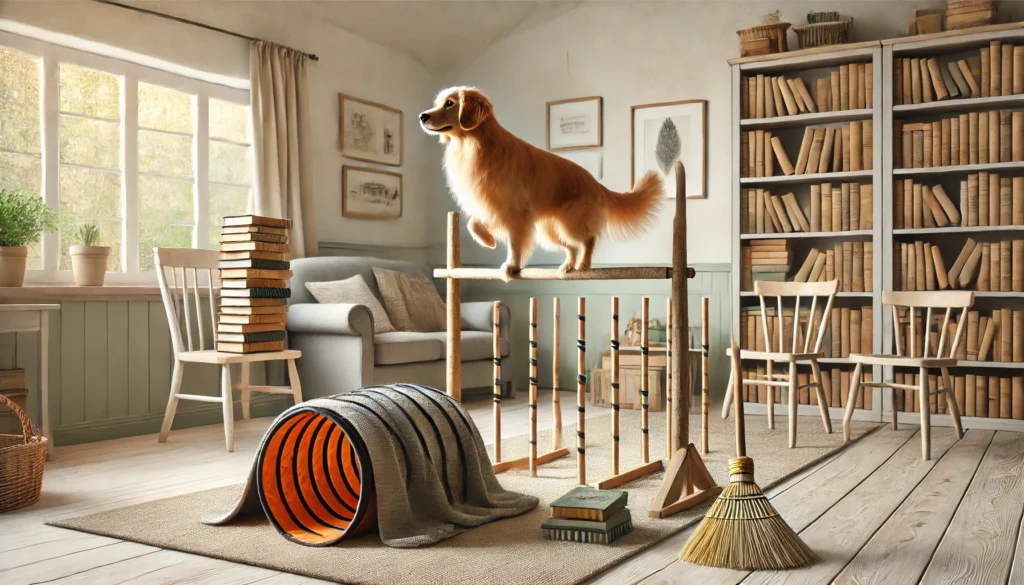Agility isn’t just for competitions or outdoor parks — it’s a fun, high-energy activity you can recreate right in your living room. Whether you have a puppy who needs stimulation or a bored adult dog in need of excitement, an indoor agility course offers physical exercise, mental challenge, and bonding opportunities.
You don’t need expensive equipment or a large space. With a few household items and creativity, you can build a safe, engaging agility course tailored to your dog’s size and energy level.
Why Indoor Agility Training Is Great for Dogs
Agility courses provide more than just physical exercise. They challenge your dog to:
- Problem-solve
- Follow commands under distraction
- Improve focus and coordination
- Build confidence
- Burn off excess energy in a controlled setting
It also strengthens communication between you and your dog while keeping things fresh and fun — especially when outdoor time is limited.
Ideal Breeds and Ages
Any dog can benefit from agility, but it’s especially effective for:
- Active breeds (Border Collies, Terriers, Shepherds, etc.)
- Puppies learning commands and spatial awareness
- Senior dogs (using low-impact versions for joint safety)
- Indoor dogs needing energy outlets
- Dogs recovering from anxiety or building confidence
Always adjust the course to your dog’s age, size, and physical limitations.
Safety First: Prep Your Space
Before setting up the course:
- Choose a space with non-slip flooring (use yoga mats or rugs if needed)
- Clear furniture and fragile objects
- Keep plenty of water nearby
- Avoid anything sharp, unstable, or easily chewed
- Use treats or toys for motivation — never force participation
Keep sessions short (10–15 minutes) and always supervise your dog while using the course.
DIY Agility Obstacles Using Household Items
Here’s how to build common agility elements with items you already have.
1. Jumps
What to use:
- Broomstick or mop handle
- Two low chairs, books, or boxes
Setup:
- Place the pole across the objects at a safe height (no higher than your dog’s elbows for beginners)
- Use a treat or toy to lure them over
- Always start low and never force jumps
2. Weave Poles
What to use:
- Plastic bottles, cones, or shoes
- Line of furniture with space to weave through
Setup:
- Space items about 1.5 feet apart
- Use a leash, treat, or hand signal to guide your dog in a zigzag pattern
3. Tunnel
What to use:
- Collapsible laundry basket with ends open
- Blanket draped over a line of chairs
- Pop-up kid’s play tunnel
Setup:
- Keep it short and straight at first
- Encourage with treats or have someone call from the other side
4. Pause Mat or Station
What to use:
- Small rug, cushion, or pet bed
Setup:
- Use the mat to train your dog to sit or lie down and “stay”
- This builds patience and reinforces impulse control
5. Crawl Tunnel
What to use:
- Low table or couch with a blanket draped to reduce height
- Line of pillows for structure
Setup:
- Lure your dog under the obstacle slowly
- Use commands like “crawl” or “under”
6. Hoop Jump
What to use:
- Hula hoop or large ring
- Sturdy base (books or pillows) to hold hoop upright
Setup:
- Start by holding the hoop low and flat on the ground
- Gradually raise height as your dog gains confidence
Combine Obstacles Into a Course
Once your dog understands each obstacle individually:
- Arrange 3–5 obstacles in a row
- Practice short sequences
- Use commands and hand signals to guide them
- Reward after completing each element or full run
Example sequence: Weave → Jump → Tunnel → Mat → Hoop
Use a consistent order for a few sessions, then switch it up to keep your dog mentally engaged.
Teaching Tips for Indoor Agility
- Keep sessions short and positive
- Use clickers, praise, or food rewards
- Avoid frustration — reset if your dog gets stuck
- Break challenges into baby steps
- End sessions on a win (successful action + reward)
Be your dog’s cheerleader — confidence comes from celebration, not correction.
Adjusting for Small Spaces
- Build U-shaped or zigzag layouts to save space
- Use furniture as part of the course (under tables, around chairs)
- Create mini courses with 2–3 rotating obstacles
If you live in an apartment, choose soft materials and avoid high-impact jumps. Focus more on crawl, pause, weave, and tunnels.
Agility for Multiple Dogs
If you have more than one dog:
- Train each one individually at first
- Rotate turns using a “wait” or “place” command
- Avoid rushing — keep energy focused and calm
- Celebrate both dogs equally to prevent jealousy
Group training promotes patience and calm focus.
Indoor Agility = Year-Round Fun
Agility training doesn’t have to wait for sunshine or a park visit. With simple tools and creativity, your home can become a playground for physical and mental stimulation.
Done right, agility becomes more than exercise — it’s a communication game that deepens trust, builds confidence, and gives your dog a sense of joyful accomplishment.
Let the living room become your agility arena — one broomstick and blanket tunnel at a time.






